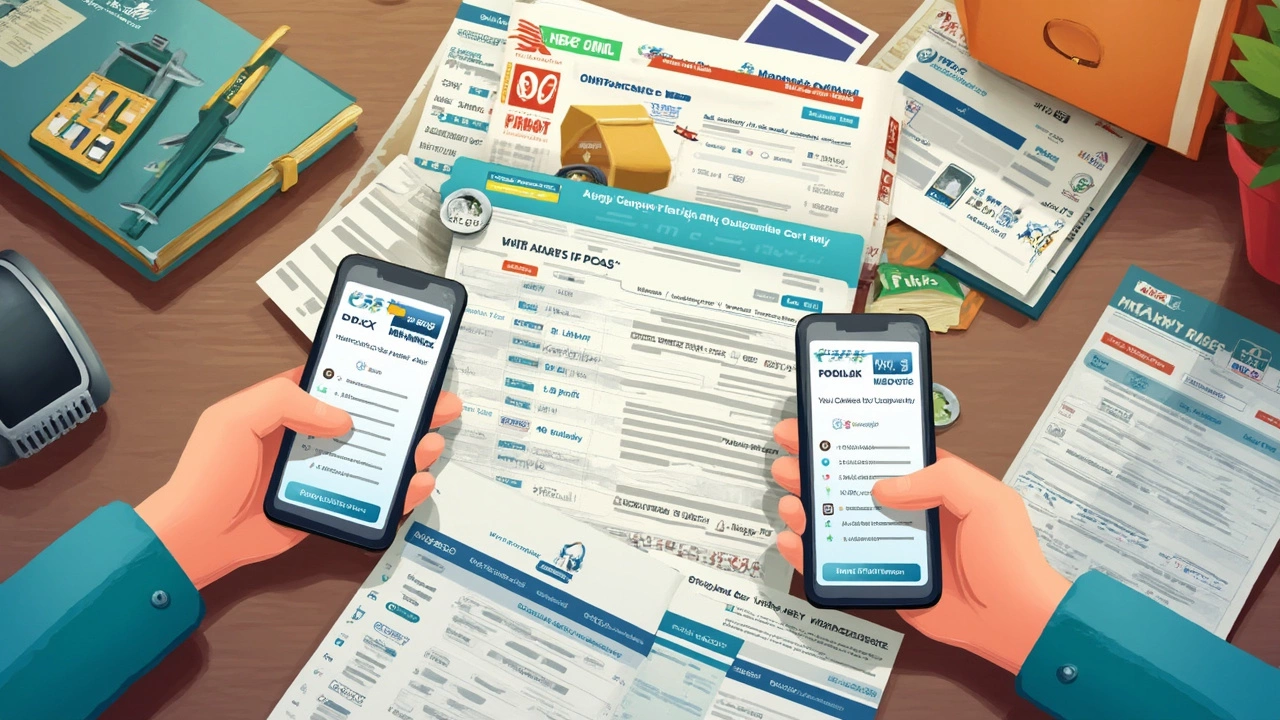The term 'express delivery' always sounds fast, but nobody really says exactly how fast until you dig into the details. Different companies throw around terms like 'overnight', 'next day', or 'two-day delivery', but the actual time can swing quite a bit depending where you live and what you’re ordering.
Major carriers say express delivery usually means one or two days within the same country—but here’s the catch: there’s almost always fine print. Cutoff times? Oh, you bet. Miss the last drop-off or place your order after a certain hour, and suddenly 'express' slips into two days or more. And if it’s the weekend or a holiday? You could be watching that tracking page a lot longer than you expected.
Want to keep your parcels from taking scenic detours? It’s all about knowing where the slow-downs happen, and how to pick the right service for the speed you actually need. Better to work with real info than trust the marketing hype.
- What Counts as Express Delivery?
- Real-World Delivery Times: Breaking Down the Numbers
- What Makes Deliveries Faster or Slower?
- Tips for Getting Your Package Sooner
What Counts as Express Delivery?
This is where things get tricky. Not every express delivery promise is the same. At its core, express shipping means your package should get from point A to point B much quicker than regular or standard shipping. But every courier defines 'express' in their own way.
Let’s break down what the biggest names actually offer:
- FedEx Express promises overnight delivery within the U.S. and in some cases, delivers before 10:30 a.m. the next day. For international, it’s usually 1-3 business days, city to city.
- UPS Express offers similar options, with overnight, two-day, and three-day services. Domestic 'Next Day Air' is their fastest, while 'Worldwide Express' usually means 1-3 days globally.
- DHL Express is all about speed for international shipments. You’ll often see 1-2 business days for high-traffic cities worldwide, but out-of-the-way spots can take a little longer.
- USPS Priority Mail Express claims overnight delivery to most U.S. addresses, but some rural areas can take two days.
Pretty fast, right? Well, there’s always a catch. Check out this quick comparison of what ‘express’ really means for common U.S. deliveries:
| Carrier | Domestic Express Delivery Time | International Express Delivery Time |
|---|---|---|
| FedEx Express | 1 day (often by 10:30 a.m.) | 1-3 days |
| UPS Next Day Air | 1 day (often by 10:30 a.m.) | 1-3 days |
| DHL Express | Not typical for domestic U.S. | 1-2 days |
| USPS Priority Mail Express | 1-2 days | 3-5 days (Priority Mail Express International) |
Retailers and couriers throw around terms like 'overnight', 'next-day', and 'express', but you’ll always want to check the actual delivery window on your order. Express can mean a day, two days, or next week if you’re out in the sticks or miss the timing cutoff.
Your biggest takeaways: express delivery is built for speed but isn’t instant. Always check small print, and don’t be shy about looking up the actual shipping policy before clicking buy.
Real-World Delivery Times: Breaking Down the Numbers
So, how fast is express delivery in practice? The big names like FedEx, UPS, DHL, and even national postal services all have their own take, but here's the lowdown you actually need:
- FedEx Express: Usually "overnight" in the US (within 1 business day). FedEx 2Day means two business days. But outside bigger cities, sometimes it stretches to 2–3 days.
- UPS Express: Next-day delivery by 10:30 a.m. or noon in most metro areas. Rural? Add some hours or even another day.
- DHL Express: In the US, usually 1–2 business days. For international express, from the US to Europe or Asia, count on 1–3 business days.
- USPS Priority Mail Express: Claims overnight delivery to most US locations, but for Alaska, Hawaii, and remote areas, it can take up to 2 days.
There’s a big difference in delivery times based on distance, time of order, weekends, and whether you’re shipping to a big city or somewhere that's off the beaten path.
| Carrier | Domestic Express Delivery Time | International Express Delivery Time |
|---|---|---|
| FedEx Express | 1 business day (most locations) | 1–3 business days (major cities) |
| UPS Express | Next-day morning/noon | 1–3 business days (main routes) |
| DHL Express | 1–2 business days | 1–3 business days |
| USPS Priority Mail Express | Overnight–2 days | 3–5 business days |
Here’s a simple but often-overlooked tip: not all "express" labels mean the same speed. Some stores sneak in an extra processing day before handing over your package, so factor that in. Another thing—during busy seasons like December or right after big sales, even express shipments might hit a speed bump.
Bottom line: the standard delivery times for express delivery usually fall between 1 and 3 business days domestically, and up to 3 days internationally if you’re lucky. Always double-check cut-off times and local holidays before counting on that quick delivery, especially if you truly need it ASAP.

What Makes Deliveries Faster or Slower?
If you’ve ever wondered why your express delivery package sometimes shows up the next morning and other times takes two days, you’re not crazy—there are a bunch of reasons behind it.
First up, location matters. Delivering to big cities is way faster than sending a box to a remote farm. Major carriers like FedEx or DHL have more trucks on busy routes, but rural deliveries might get dropped to once a day, or even every other day.
Time of day you order is another dealbreaker. Miss the company’s daily order cutoff (often around 3-6 pm local time), and your package sits until the next day. This alone can double your wait, so always check the exact cutoff before clicking buy.
Weekends and holidays? Yeah, those slow things down. Most express delivery options don’t run on Sundays, and national holidays can seriously jam up the schedule. If you need something fast, avoid shipping right before a holiday rush.
Customs clearance is the wild card for international express delivery. Even if the courier promises 1-3 days, customs could hold packages for random inspections, adding another day or more in some cases.
Here are the main factors that make or break delivery speed:
- Destination—Urban vs. rural really matters
- Order cutoff time—Miss it, add a day
- Weekends/holidays—Most companies don’t count these
- Weather—Storms, floods, or even heavy snow stall everything
- Customs—For anything crossing borders
- Courier’s own network—Some companies just have better local reach
Take a look at this quick breakdown of average extra time these issues can add:
| Delay Factor | Possible Extra Time |
|---|---|
| Cutoff missed | +24 hours |
| Major holiday | +1-3 days |
| Customs inspection | +1-2 days |
| Severe weather | Variable (depends on severity) |
| Rural delivery area | +1 day |
Want things to go faster? Double check all the small print and local rules before you ship. It’s the small stuff that usually turns speedy deliveries into waiting games.
Tips for Getting Your Package Sooner
If you’re counting on express delivery to save the day, it pays to know all the shortcuts and common snags. Here’s what actually works when you want your package ASAP.
- Order Early: Most couriers have strict cutoff times—miss them by even a few minutes, and your express delivery bumps to the next day. Common cutoffs are between 2 p.m. and 6 p.m. Double-check during busy seasons because they sometimes end earlier.
- Avoid Weekends and Holidays: Express services usually don't move as fast on Saturdays and Sundays. UPS and FedEx, for example, only offer guaranteed Saturday delivery for an extra fee, and many places skip Sundays completely.
- Check for Remote Areas: Rural locations often add an extra day, even for express delivery. If you’re shipping to or from the middle of nowhere, call the courier to ask for a realistic timeline.
- Go for Guaranteed Services: Choose options labeled "guaranteed overnight" or "guaranteed next day." Some budget express services only aim for two business days, and those aren’t nearly as fast.
- Label and Address Everything Clearly: Mislabeled packages are the #1 reason for express delays besides missed cutoffs. Double-check the address, apartment number, and phone number to keep your package on track.
- Track and Get Notifications: Most major couriers let you sign up for real-time tracking updates. If you spot a delay, call customer service right away—they can sometimes speed things up or reroute for pickup.
Here’s a quick peek at how cut-off times stack up at the three big carriers for express delivery as of this year:
| Carrier | Same-Day Cutoff | Guaranteed Services |
|---|---|---|
| FedEx | 6 p.m. (varies by location) | First Overnight, Priority Overnight |
| UPS | 5 p.m. (varies by location) | Next Day Air, Next Day Air Saver |
| DHL | 4 p.m. (varies by location) | Express Worldwide |
One more thing: shipping right before a holiday or just after a big sale (think Black Friday) can stretch delivery times by a full day or more, even with express service. If it absolutely needs to arrive fast, ship a day early or spring for the best guarantee you can.





